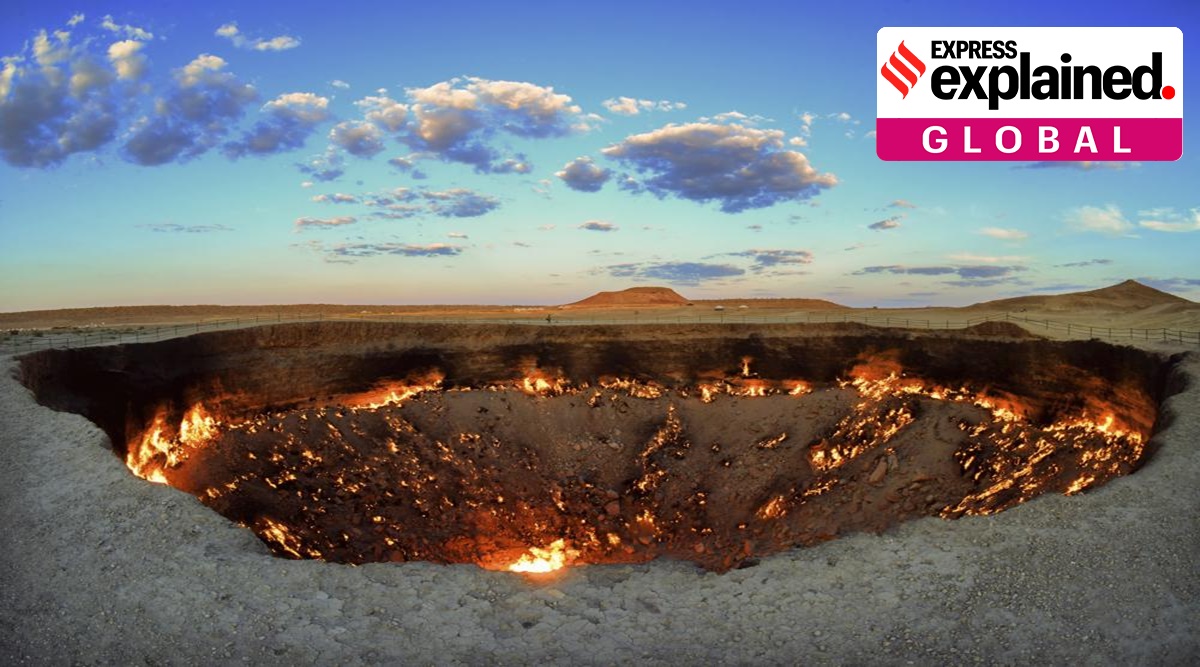Explained: Why does Turkmenistan plan to close its ‘Gateway to Hell’?

Turkmenistan President Gurbanguly Berdymukhamedov has ordered experts to find a way to extinguish a fire in a huge natural gas crater, the Darvaza gas crater also known as the ‘Gateway to Hell’.
Located in the Karakum desert, 260 kilometres away from Turkmenistan’s capital, Ashgabat, the crater has been burning for the last 50 years.
What is the ‘Gateway to Hell’?
The crater is 69 metres wide and 30 metres deep. While the details of the origin of the crater are contested but it has been said that the crater was created in 1971 during a Soviet drilling operation.
As reported by the BBC, in 1971, Soviet geologists were drilling for oil in the Karakum desert when they hit a pocket of natural gas by mistake, which caused the earth to collapse and ended up forming three huge sinkholes. This pocket of natural gas contained methane, hence to stop that methane from leaking into the atmosphere, the scientists lit it with fire, assuming the gas present in the pit would burn out within a few weeks.
Although, the scientists seemed to have misjudged the amount of gas present in the pit, because the crater has been on fire for five decades now. As reported by the U.S. Energy Information Administration, “Turkmenistan is one of the five Caspian Sea littoral countries, an area with large volumes of oil and natural gas reserves.”
Locals have also said that the crater was formed in the 1960s but wasn’t lit on fire until the 1980s. It has also been said that since oil and gas were very expensive commodities during Soviet rule, the formation of the crater has remained a confidential piece of information.
The crater has become a significant tourist attraction in the country. As reported by the BBC, it sees around 6,000 tourists per year. In 2018, the country’s president Gurbanguly Berdymukhamedov officially renamed it as the “Shining of Karakum”.
In 2013, Berdymukhamedov created a nature reserve in the Karakum desert, which included the burning crater.
Why did Turkmenistan’s President order to extinguish it?
Calling it a human-made crater, Berdymukhamedov said it “negatively affects both the environment and the health of the people living nearby”, AFP reported.
He added, “We are losing valuable natural resources for which we could get significant profits and use them for improving the wellbeing of our people.”
In 2010 too, Berdymukhamedov had visited the crater and asked local officials to find a way to extinguish the crater. As reported by Reuters, he had also asked the authorities to ensure that it does not hinder the development in the gas field near the crater. Berdymukhamedov had said, “Existing anomalies have hindered the accelerated industrial development of the subsoil riches of central Karakum”.
According to the International Trade Administration, Turkmenistan produced 63.2 billion cubic meters of gas in 2019. Reuters, in 2010, had reported that the country wanted to triple the output over the next few decades to expand sales beyond Russia, China and Iran and into Western Europe, India and Pakistan.
Has anyone ever gone inside the burning crater?
In 2013, George Kourounis, a Canadian adventurer, was the first person to go inside the crater in an expedition funded by National Geographic. According to his interview with National Geographic, Kourounis said that he prepared for a year and a half before going into the crater.
Newsletter | Click to get the day’s best explainers in your inbox
Kourounis went inside the pit, which he described as the “coliseum of fire”, and took soil samples from within the crater to find a sign of “microbial life-forms that are thriving in the hot, methane-rich environment”. And according to his interview, the scientists were able to find bacteria living amidst the burning crater. “The most important thing was that they were not found in any of the surrounding soil outside of the crater”, Kourounis added.
How harmful are methane leaks?
According to the United Nations Environment Programme, “Methane is the primary contributor to the formation of ground-level ozone, a hazardous air pollutant and greenhouse gas, exposure to which causes 1 million premature deaths every year. Methane is also a powerful greenhouse gas. Over a 20-year period, it is 80 times more potent at warming than carbon dioxide.”
Turkmenistan has been at the centre of methane leakages. As per a Bloomberg report, out of the 50 most severe methane gas leakages onshore oil and gas operations in 2019, 31 were in Turkmenistan. In addition to this, one of these leakages, “had a climate impact roughly equivalent to the annual emissions of all the cars in Arizona”.

“평생 사상가. 웹 광신자. 좀비 중독자. 커뮤니케이터. 창조자. 프리랜서 여행 애호가.”

